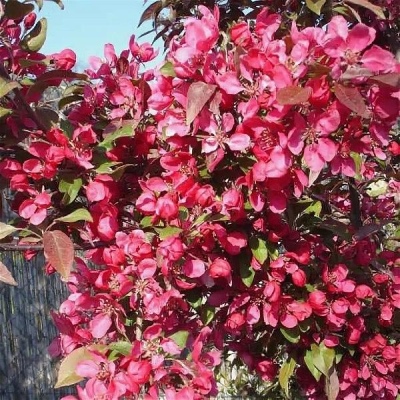
- Fruit size: small
- Growing regions: Moscow region
- Name synonyms: Scarlett
- Decorative: Yes
- Height: up to 4 m
- Crown: columnar luxurious
- Escapes: purple, later brown
- Flowers: dark pink
- Coloration: purple
- Fruit shape: round
Among the numerous apple varieties, decorative ones are a separate group. Such apple trees are extremely aesthetic during flowering, some have a beautiful shade of foliage throughout the growing season. Among them is the Scarlet ornamental apple tree, synonymous with Scarlett.
Description of the variety
A very beautiful tree at the time of spring flowering. Scarlet blooms profusely in May with dark pink flowers. The total mass of flowers gives the impression of a huge fragrant head, turning into purple hues.
The height of the tree reaches 4 meters. Young shoots are purple in color, brown with age. The branches of the apple tree are covered with medium-sized deep-lobed foliage. The foliage color is brownish-red in early spring, greenish-purple in summer, brown-orange or red in autumn. Crohn Scarlet has a luxurious columnar shape.
At the time of full maturity, the tree enters 7 years, the crown diameter reaches 4 meters. The purpose of the apple tree is a tapeworm, but it looks no less beautiful in small groups if they are planted in a large area.
Features, pros and cons
A pronounced feature of the variety is the bloom with dark pink flowers. Therefore, its high decorative qualities can be considered a plus. The apple tree gives fruits, but they are so small that only birds eat them. This is a serious disadvantage - not everyone can afford to grow a large tree in a small area just because of its decorative effect.
Ripening and fruiting
Scarlet bears fruit as abundantly as it blooms. By autumn, the tree is covered with small purple ranetka apples. They ripen in October-November. Remaining on the tree, they serve as a nutritional supplement in the diet of feathered city dwellers.
Growing regions
The variety is adapted for cultivation in Moscow and the Moscow region, but grows well throughout central Russia.
Yield
Scarlet's yield can be called conditionally high. The thing is that no one collects small fruits, much less weighs them - they remain on the tree. However, the fact that almost all flowers form an ovary and subsequently fruits, gives the right to speak about the high fruiting of the variety.
Fruits and their taste
Small rounded apples are purple in color and have a pronounced sweet apple flavor. Because of their small fruitiness, people do not collect them, but the birds love to feast on them, especially after the frost hits. Increased sugar content can lead to fermentation if prolonged warm weather sets in after frost.

Growing features
For planting, choose sunny places, preferably protected from strong winds, since young trees may suffer.The soil should be fertile, loose, moderately moist, with good drainage. Strong wind is not a hindrance to large apple trees, but it can knock off the color, as a result decorativeness will suffer.
For planting seedlings, standard pits of 80x80 cm are dug, the excavated soil is enriched with organic matter and complex mineral fertilizers. In the depths of the hole, they make a mound, set a plant on it, gently spread the roots along the slopes and fall asleep, spill abundantly. If several apple trees are planted, then the distance between them should be at least two meters.



Pollination
The aroma and sweetness of the flowers attract bees and bumblebees that pollinate the apple tree.
Top dressing
In the first two years, young plants do not need feeding if the soil was properly filled with nutrients during planting. Subsequently, traditional fertilizers are used: nitrogen fertilizers in the spring, phosphorus in the summer, and organic matter in the fall.

Frost resistance
The variety has good frost resistance and easily tolerates the winters characteristic of the middle lane.

Diseases and pests
The Scarlet apple tree is affected by pests such as aphids and bark beetles. Of the diseases, scab and cancer are dangerous for her. A complete cure for black cancer on fruit trees is possible with the help of modern means, but only in the early stages. Careful observation of the plantings is imperative, especially since the cancer spreads very quickly and is able to destroy the entire garden within two years. For parasites, preventive treatments with insecticides are used, for scab and cancer - Bordeaux liquid in early spring and antifungal drugs.

The apple tree is a popular fruit crop among gardeners. It can be found in many summer cottages. But at the same time, such trees are often affected by various diseases. It is very important to recognize the disease in time and carry out the necessary procedures for a speedy recovery. Otherwise, the fruits will be spoiled, and the tree itself may die altogether.












































































